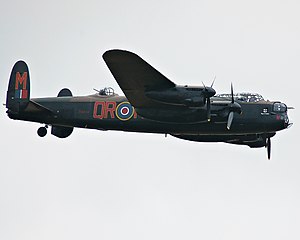Avro Lancaster
| Lancaster | |
|---|---|
 |
|
| Royal Air Force Avro Lancaster B I PA474 of the Battle of Britain Memorial Flight. This aircraft carries the deepened bomb aimer's blister (Mod. 780), and the later paddle-bladed propellers. Neither H2S blister nor exhaust shrouds are fitted. | |
| Role | Heavy bomber |
| Manufacturer | Avro |
| Designer | Roy Chadwick |
| First flight | 9 January 1941 |
| Introduction | February 1942 |
| Retired | 1963 (Canada) |
| Primary users |
Royal Air Force Royal Canadian Air Force Royal Australian Air Force |
| Number built | 7,377 |
| Unit cost |
£45–50,000
|
| Developed from | Avro Manchester |
| Variants | Avro Lancastrian |
| Developed into |
Avro York Avro Lincoln |
The Avro Lancaster is a British four-engined Second World War heavy bomber designed and built by Avro for the Royal Air Force (RAF). It first saw active service with RAF Bomber Command in 1942 and, as the strategic bombing offensive over Europe gathered momentum, it was the central implement for the night-time bombing campaigns that followed. It became the main heavy bomber used by the RAF, the RCAF, and squadrons from other Commonwealth and European countries serving within the RAF, overshadowing its close contemporaries the Handley Page Halifax and Short Stirling. The "Lanc", as it was affectionately known, thus became one of the more famous and most successful of the Second World War night bombers, "delivering 608,612 long tons of bombs in 156,000 sorties." The Lancaster, an evolution of the troublesome Avro Manchester, was designed by Roy Chadwick and was powered by four Rolls-Royce Merlins, or, in one version, Bristol Hercules engines.
A long, unobstructed bomb bay meant that the Lancaster could take the largest bombs used by the RAF, including the 4,000 lb (1,800 kg), 8,000 lb (3,600 kg), and 12,000 lb (5,400 kg) blockbusters, loads often supplemented with smaller bombs or incendiaries. The versatility of the Lancaster was such that it was chosen to equip 617 Squadron and was modified to carry the Upkeep "Bouncing bomb" designed by Barnes Wallis for Operation Chastise, the attack on Germany Ruhr Valley dams. Although the Lancaster was primarily a night bomber, it excelled in many other roles, including daylight precision bombing: in the latter role some Lancasters were adapted to carry the 12,000 lb (5,400 kg) Tallboy and then the 22,000 lb (10,000 kg) Grand Slam earthquake bombs (also designed by Wallis).
...
Wikipedia
